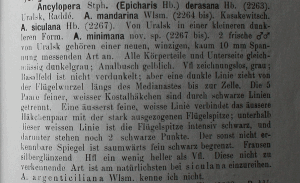

 +4Kontinente:EUAS
+4Kontinente:EUAS2. Diagnose
2.1. Erstbeschreibung
3. Biologie
3.1. Nahrung der Raupe
- [Elaeagnaceae:]Hippophae sp. ? (Sanddorn ?)
Nach Anikin et al. (2017: 167) noch unbekannt. Trematerra et al. (2021: 50) schreiben aber: "Larva found on buckthorn Hippophae spp." - woher die Angabe stammt, bleibt unklar.
4. Weitere Informationen
4.1. Andere Kombinationen
- Anchylopera minimana Caradja, 1916 [Originalkombination]
4.2. Synonyme
- Anchylopera minima Popescu-Gorj, 1992
4.3. Faunistik
Die Art wurde "von Uralsk" beschrieben, also der Umgebung von Oral im Norden des europäischen Teils von Kasachstan. Anikin et al. (2017: 167) melden die Art aus dem Süden des europäischen Teils von Russland aus den Oblasten Volgograd und Saratov, kennen aber keine neueren Angaben aus der Oblast Uralsk.
Trematerra et al. (2021: 50) überraschen mit dem Erstmeldung für das Gargano-Gebiet am Sporn von Italien. Da dort gleich 2 Weibchen im Abstand von 2 Wochen gefunden wurden, war kaum von Verschleppung von Einzelexemplaren auszugehen: "1 female, Vico del Gargano (Foggia), 579 m, 16.VI.2020, leg. Goglia and Palmieri; 1 female, idem, 559 m, 1.VII.2020." Zur Verbreitung ist in der Folge zu lesen: "From Eastern and SE parts of E-Europe to Ciscaucasia and Ural Mts, Caucasus. (Italy: Puglia)." Nach Knud Larsen (E-Mail 19. Dezember 2021 an E. Rennwald) sind die Autoren aber offensichtlich einer Fehlbestimmung aufgesessen. Er begründet ausführlich und überzeugend: "In Lepiforum this species is mentioned from Italy with reference to Trematerra et al. in Redia vol. 104 2021. The species is documented by a picture of imago and the female genitalia (ostium). Both pictures of imago and of genitalia very clearly show Ancylis achatana without any doubt. Before the mirror there is a dark triangle reaching two thirds up on the wing and the mirror is very large and whitish. The picture shows a broadwinged species with only slightly pointed apex. These characters are the main diagnostic characters of achatana. A. minimana is small, narrow winged, apex pointed and nearly no mirror. Besides, it has a dark median line in the inner half of the wing. Easely to see at Plate V fig. 141 in Razowski, 2003). Females of A. achatana can sometimes be smaller than the males. The genitalia are also different. A. minimana has a rounded ostium whereas achatana has a strong sclerotized ostium pointed to either side. If you compare the picture in Redia with the picture of the female genitalia of A. achatana in Lepiforum they are completely alike. I think that they have been tricked by the smaller size and the sketches of the genitalia in Razowski. If you read the original description of minimana you will see that it fits exactly to the picture in Razowski and not at all to the picture in Trematerra." Die Angabe von A. minimana für Italien ist demnach wieder zu streichen.
(Autor: Erwin Rennwald)
4.4. Literatur
- Anikin, V.V., Sachkov, S.A. & V.V. Zolotuhin (2017): "Fauna lepidopterologica Volgo-Uralensis": from P. Pallas to present days. — Proceedings of the Museum Witt Munich, Volume 7: 1-696; Munich and Vilnius.
- Erstbeschreibung: Caradja, A. (1916): Beitrag zur Kenntnis der geographischen Verbreitung der Pyraliden und Tortriciden des europäischen Faunengebietes, nebst Beschreibung neuer Formen. — Deutsche Entomologische Zeitschrift „Iris“ 30: 1-88, 151-152. Dresden.
- Trematerra, P., Goglia, L. & M. Colacci (2021): Faunistic notes on Lepidoptera Tortricidae of Gargano territory with recording of Ancylis minimana (Caradja, 1916) new to Italy. — Redia 104: 45-53. [PDF auf redia.it]





